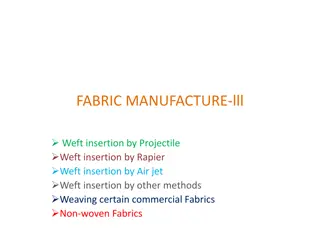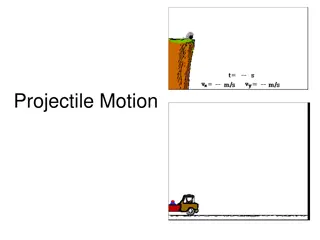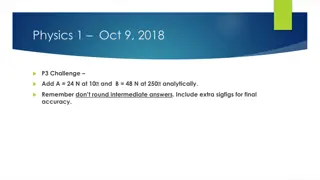Understanding Projectile Motion: Components and Trajectories
Projectile motion involves the horizontal and vertical components of motion, where objects follow parabolic trajectories under the influence of gravity. The horizontal and vertical motions are independent of each other, leading to a variety of curved paths. This phenomenon is illustrated through examples and the effects of gravity on objects in motion.
Download Presentation

Please find below an Image/Link to download the presentation.
The content on the website is provided AS IS for your information and personal use only. It may not be sold, licensed, or shared on other websites without obtaining consent from the author. Download presentation by click this link. If you encounter any issues during the download, it is possible that the publisher has removed the file from their server.
E N D
Presentation Transcript
CHAPTER 5 PROJECTILE MOTION Projectile motion can be described by the horizontal and vertical components of motion.
5.4 PROJECTILE MOTION
5.4 Projectile Motion A projectile is any object that moves through the air or space, acted on only by gravity. Examples:
Projectiles near the surface of Earth follow a curved path called a trajectory. The shape of a projectile s trajectory is a parabola.
Projectile motion can be separated into components. a. Roll a ballalong a horizontal surface, and its velocity is constant because no component of gravitational force acts horizontally. b. Drop it, and it accelerates downward and covers a greater vertical distance each second.
Most important, the horizontal component of motion for a projectile is completely independent of the vertical component of motion. Each component is independent of the other. Their combined effects produce the variety of curved paths that projectiles follow.
A strobe-light photo of two balls released simultaneously one ball drops freely while the other one is projected horizontally.
5.5 PROJECTILES LAUNCHED HORIZONTALLY
5.5 Projectiles Launched Horizontally There are two important things to notice in the photo of two balls falling simultaneously:
HORIZONTAL The ball s horizontal component of motion remains constant. Gravity acts only downward, so the only acceleration of the ball is downward
VERTICAL Both balls fall the same vertical distance in the same time. The vertical distance fallen has nothing to do with the horizontal component of motion.
think! At the instant a horizontally pointed cannon is fired, a cannonball held at the cannon s side is released and drops to the ground. Which cannonball strikes the ground first, the one fired from the cannon or the one dropped?
Answer: Both cannonballs fall the same vertical distance with the same acceleration g and therefore strike the ground at the same time.























